On is a Swiss running shoe company born from the desires of three friends (one a three-time World Champion Duathlete and Ironman Competitor) who thought they could do a better job designing a shoe that felt and performed differently than anything else on the market.
By: Christa Davidson

The Feel
When I put the shoe on I could feel the support but was confused by the lightness and overall flexibility of the midsole. Often, for stability the midsole is much less flexible than it is in this shoe. The bottom line pride of design behind this shoe is that it provides a cushioned landing while offering a firm take off; that the shoe will give you what you need when you need it. I definitely felt what they are marketing. I could appreciate the cushioned soft landing delivered by the ‘clouds’ and I could feel the road/treadmill as I was pushing off. My toes felt free and unrestricted and there was no intolerable bunion friction, which is a design feature of On’s horizontal toe box.
The Tech
The cloud design feature is standard to the On running shoe line. The midsole is made up of pockets known as clouds and On calls this ‘CloudTec’. The clouds create a soft landing and as they are decompressed allow a firm, stable platform from which to toe off. The company says this technology shouldn’t be thought of as ‘spring loaded’, you are still doing the push off, but the shoes do provide a forward feeling momentum. Plus, the lacing design is an interesting feature known as the ‘star lacing system’ which removes pressure points on the top of the foot while maintaining securely tied laces.
The Final Kick
The world is a better place for its dreamers and doers. On has received a lot of support and positive feedback for their shoes. If you still haven’t found your ‘go-to’ shoe or if you like to try everything out then the Cloudflyer is a worthy option. I enjoyed running in them on the roads and treadmill and had no problems.
Asics is a Japanese company in 1949. The company was founded on the idea that everyone deserved good shoes for activity. The name itself is an acronym for the Latin phrase ‘anima sana in corpore sano’ which roughly translates to ‘healthy soul in a healthy body’. The Asics GT 2000 is the company’s fourth version to this model. 
The Feel
When I put the 2000 on I could immediately feel the reliability that I could see. The shoe felt supportive, as if it said, ‘we’re good here’. I ran on the roads and on the treadmill with this shoe and felt the cushiony support that Asics claims. I usually wear a women’s size 7.5 and I think in this shoe I would go a half size bigger.
The Tech
This shoe is classed as a stability shoe that suits runners who over pronate. The technology that supports the classification includes a rear and forefoot ‘Gel’ cushioning system to support landing and to enhance toe-off. The ‘duomax’ sole that we have become familiar with is placed in the midsole of support. We are also used to seeing or hearing about Asics’ ‘Impact Guidance System’ or ‘IGS’. This technology is used to support the runner’s natural gait from heel strike to toe-off. The shoe weighs about 8.4oz. The heel height is 21mm and the forefoot height measures 11mm. The price is $169.99 and you can find the shoe at running stores big and small, across Canada as well as on the Asics website.
The Final Kick
The GT 2000 4 is a durable, supportive shoe. I could feel the support immediately when I put the shoe on. If you are looking for a shoe that supports your natural gait in all the right ways but helps to gently keep you out of trouble, then you may want to check this model out.
Hoka One One Originated in France in 2009 and was co-founded by two ultra distance runners who wanted shoes that would allow them to run farther longer. In 2010 these trail, road and hiking shoes landed in the U.S. market and have now made their way to Canada. And while these kicks might looked a bit too comfy to be taken seriously, Christa Davidson shares her discovery.
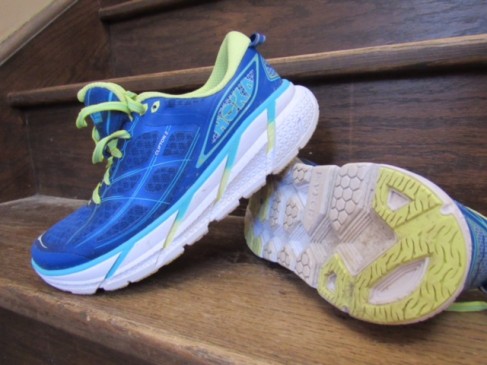
The Feel
When I initially put the Clifton 2’s on my feet, the first thing I thought was, “that’s a lot of shoe”, the second thing that came to mind very quickly was “so light for so much shoe”. As I ran on the roads and the treadmill, I continued to be wooed by the soft, easy, fluffy landing the shoes were serving. I was reminded of my original impression of these shoes looking like lunar footwear and was pleased to be wrong about any heavy, bulky characteristics that you would expect from space wear. The Clifton’s are light, responsive, quick and comfortable.
The Tech
A neutral shoe, the latest version of the Clifton has a few updates. First, a softer, padded tongue for increased comfort across the top of the foot. There are improvements to the midfoot support in the form of structural overlays. The shoe weighs in at 7.2oz/203gms and has a 5mm offset from heel to toe with the heel stack height measuring 28mm. Its ride and responsiveness is aided by a Meta-rocker design which works to propel and move you forward through your gait. Hoka describes this as their lightest, fastest shoe and markets it to road runners of all speeds and distances. You can find the Clifton at the Running Room and most other specialty running stores across Canada, as well as at Mountain Equipment Co-op locations. The retail cost of this shoe is $169.
The Final Kick
There are plenty of great neutral, cushioned road shoes, and the Clifton 2 is one that’s definitely worth a try. For heel strikers in particular, this just might be your perfect ride. Even better? Hoka makes it risk free to try their shoes, in that they offer a 30 day trial with a no risk return policy if you don’t love them. I ran relaxed, comfortable kilometers in this shoe, as well as a tempo run and had none of my typical Achilles or heel complaints the days following. Sometimes a change in thinking is good for us. If less shoe is doing you no favours, I urge to give a bit more of a shoe a try. You never know until you try.
The Saucony logo was inspired by the Saucony Creek which flows through the Pennsylvania town of Kutztown, where the shoe company has its origins. Saucony is a native word that seems to translate to: ‘the river’s mouth’.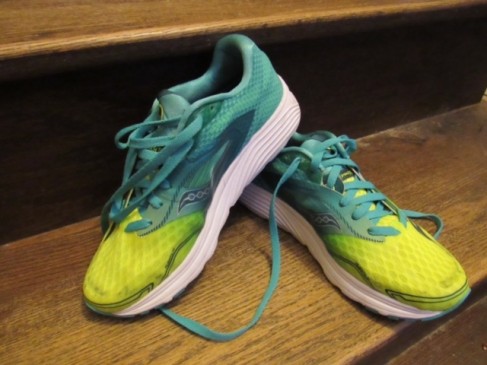
THE FEEL
When I started running again five years ago, I was wearing stability shoes that felt like cement blocks on my feet so when I put shoes on that feel like I am wearing socks, it is a sensory treat. The Kinvara 7’s are light, cushiony and designed to be a natural shoe and as such give you an honest feel of the surface you are running on. I ran in them on a treadmill, a track that is surfaced in rubber, on bare roads and just for kicks, on snowy roads with Yaktrax on. The shoe isn’t designed for the latter but with the help of extra grip I found it comfortable.
THE TECH
Saucony uses a cushioning technology in the midsole called Everun which has been used in other models bit is new to this shoe. In the Kinvara 7’s the Everun is used in the heel of the shoe for a more comfortable landing and takeoff.
Flexfilm covers the areas around the front and is exactly what you imagine it to be from its name: a flexible film. The adaptability of the Flexfilm gives my foot the ability to move and be how it needs to be while I run. It doesn’t feel restrictive or contained and there is no rubbing, which supports Saucony’s design theme of this being a natural shoe. And the last feature that is notable in this shoe is the Prolock lacing system that helps keep the shoe laced for a loose or snug fit.
FINAL KICK
Saucony sponsored runner, David Freake is experienced with previous versions of this shoe and says, ‘The biggest difference (between the Kinvara 6 and 7) comes in the tooling of the outsole/topsole with the addition of Everun. You immediately notice the increase of energy return when you land in your gait cycle. From an upper standpoint you will find it very similar to the previous model’.
After finishing their races, Skechers sponsored athlete Josh Bolton got down on one knee and proposed marriage to his girlfriend Tanis Smith, who is also a Skechers sponsored athlete. Josh loves Tanis, Skechers loves Josh and Tanis and I love Skechers’ GoRun 4’s, which both Josh and Tanis were wearing on Sunday when they won their races and became blissfully betrothed to one another.

The Feel
These shoes are cushiony and you can feel it but you can still get a good sense and feel of the ground beneath you. The shoes were light and easy to run in while feeling supportive at the same time. You could run some fast splits in these lovelies. I ran outdoors and on the treadmill with them and felt like I could do a lot of running in them as they are soft and flexible.
The Tech
Skechers crafts the upper of this shoe from their ‘GoKnit’ fabric which is light, breathable and seamless. This is an upper that allows your foot to move naturally while still being supported. Knit uppers are great for many reasons but my personal experience of living and running with a foothill sized bunion (yes, I had to) is there is less friction and rubbing of protrusive areas which for me means no blisters and decreased calluses.
The GoRun is a classed as a neutral cushioned shoe. The midsole is designed with Skechers’ ‘Resalyte Power Pillar’ technology which is a supportive material located in the mid-foot strike zone. The material gives a ‘pop’ feel on push off, which is not the same as bounce and is another way to describe its responsiveness.
The Last Kick
You can get your hands on and feet into Skechers Performance shoe line, which includes the GoRun 4 at Skechers retail stores as well as selected specialty shoe stores in Canada. This shoe is moving to my top shoe shelf which is houses all my favorite rides. If you are in the market for a responsive, light and fast neutral shoe, give this one a look. Meb loves it, Kara loves it, ‘Jo-Tan’ loves it and I love it…so much freaking love. Now, to wait for my invitation to the Skechers wedding of the year. Congratulations Josh and Tanis, on your collective triple win this past Sunday.
Under Armour Gemini 2 with UA Record
We have come to know Under Armour as a sports apparel brand but they are also a shoe manufacturer and not just football cleats, running shoes too. They have a full line of running shoes to choose from. The UA Gemini 2 equipped with UA Record has been described as a smart shoe because it includes the shoe, the armband, the Health Box, a heart rate monitor and it all syncs with UA Health Record, UA MapMyRun and UA MyFitnessPal I will have a more comprehensive review of the technology associated with this shoe coming in an additional post.
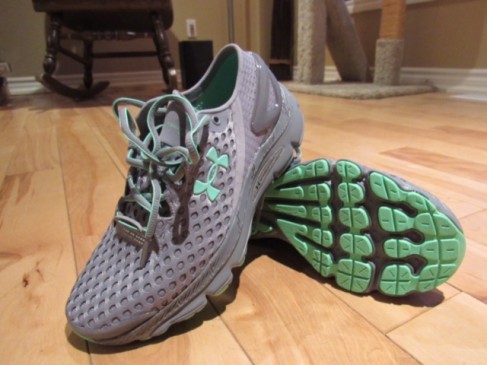
THE FEEL
The shoe upper is made from a light, flexible and breathable, comfortable fabric. There is a small area of toe reinforcement but nothing to rub or impede the outer areas of the forefoot, therefore there was no rubbing or friction to cause blisters or discomfort. I would say the toe box is on the wider side which allowed my toes to splay naturally, which makes my bunion happy. The midsole is cushiony and supportive with landing and responsive on takeoff. For shorter runs I am tending to like the feel of a barely there shoe and I would say this shoe fits the bill. There is great debate about running with or without socks. I am a pro-socker but this is a shoe that I could try running in without socks, if that tells you anything.
THE TECH
Ok, so the window is wide when talking ‘tech’ about this shoe. First let’s look at the structural tech of the shoe. The shoe’s tongue is not overly padded, which I like. It is also off set at the ankle sitting a bit higher to the inner side. Without the extra padding, this is actually unnoticeable and in no way bothered me. The shoe is supportive in the midsole and cushiony when landing. There is heel support to help stabilize your landing. Otherwise there isn’t a lot of structural tech info available on the shoe. On the ‘smart’ side of things, you will find that this shoe is plugged in, without being plugged in, if you know what I mean. The right shoe has a blue tooth sensor in it that tracks your distance, pace, time and even cadence and it all syncs to the UA Record app. This means that you can run without your phone; hands free. This is not an new industry phenomenon but it is new and exciting for UA. The UA Healthbox which is a weigh scale that also calculates your body fat and through Bluetooth/Wifi sends to the app. There is an armband which tracks your activity, sleep and heart rate and sends to the app as well. In short, all of your health/activity stats are in one place, on your phone. I will be using all of this over the next while and will give a more comprehensive explanation of my experience.



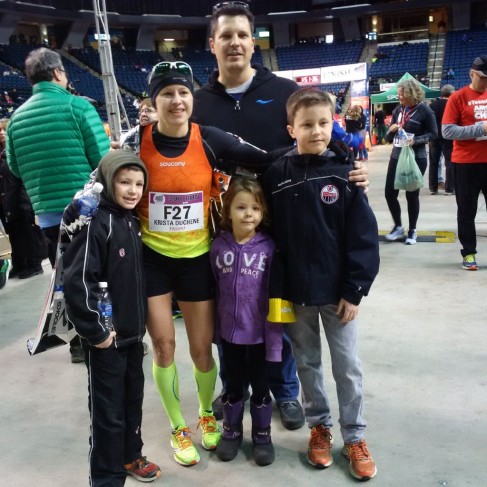










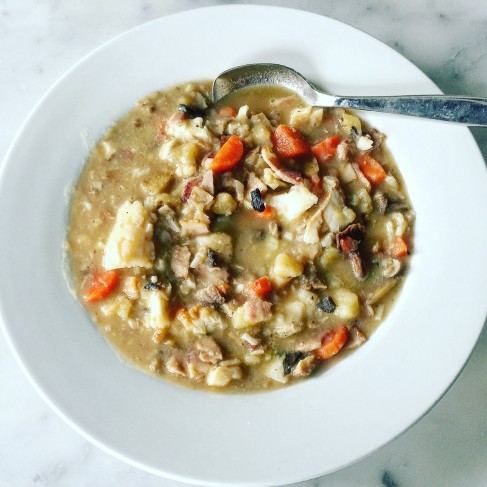



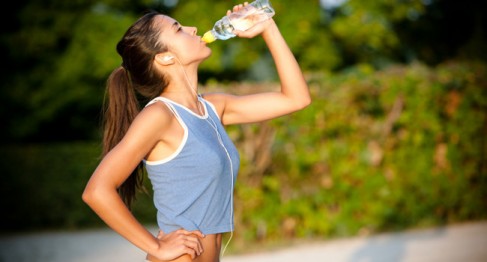



 Our Magazine
Our Magazine
